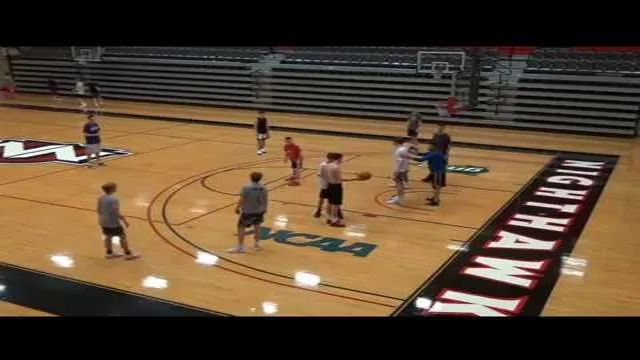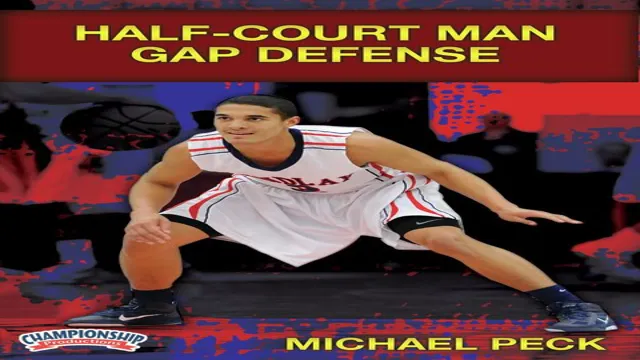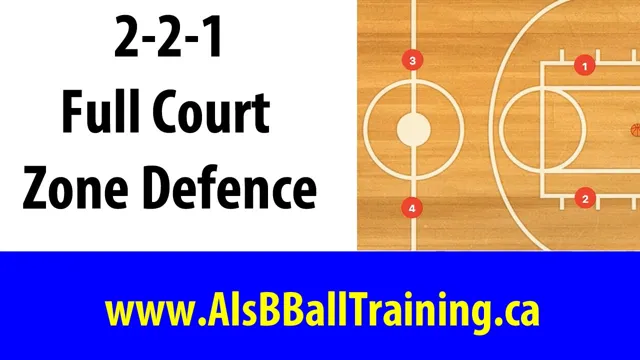Do you often find yourself struggling to defend against quick and agile basketball players who always seem to find a way through your defense? If so, you’re not alone. Many basketball players struggle with gap defense, which requires quick reflexes and tactical positioning to keep your opponent from penetrating the defense. However, mastering gap defense is essential if you want to become an all-around defensive powerhouse on the court.
In this blog, we’ll explore the ins and outs of gap defense, including tips and strategies for mastering this crucial aspect of basketball. So, whether you’re a seasoned pro or just starting, read on to learn how you can take your basketball defense to the next level!
The Importance Of Gap Defense
Basketball gap defense is an essential element that coaches teach their teams to master for effective play. It’s the strategy of closing space between defenders, preventing an opponent from breaking through to create offensive opportunities. Effective gap defense requires players to read a game, anticipate movements, communicate with their teammates, and stay within their defensive positioning.
This tactic is specifically employed when the other team has possession of the ball, with defenders forming a line between the offensive player and the basket. The defense aims to steer the offensive player towards an unfavorable shooting position and discourage the use of dribbling and passing lanes. With a steady and well-practiced gap defense, a team can effectively stifle their opponent’s offensive plays, creating fewer scoring opportunities for them.
Limiting High Percentage Shots
Gap defense is a crucial aspect of limiting high percentage shots in basketball. It refers to the space between an offensive player and the defender guarding them. By maintaining a gap, the defender can quickly close in on the offensive player if they attempt to make a move to the basket.
This helps to restrict their options and forces them to take low percentage shots. Good gap defense requires players to be aware of both their position on the court and the movements of their opponents. It’s a skill that takes time to develop, but it can be the difference between conceding easy baskets or forcing the offense into making tough shots.
Ultimately, by implementing effective gap defense, teams can reduce the number of high percentage shots taken by their opponents, giving them a greater chance of winning the game.

Forcing Opponents To Shoot Outside The Paint
If you want to be a dominant basketball player, you need to learn how to force your opponents to shoot outside the paint. That’s where gap defense comes in. Gap defense is all about shutting down the pathways to the basket, by clogging up the gaps between defenders.
This puts pressure on the ball handler to either take low-percentage outside shots or try to navigate through the congestion, which often results in turnovers or bad shots. It’s a high-risk, high-reward strategy that requires excellent communication and discipline on the court, but when executed properly, it can be incredibly effective in stifling opposing offenses. By focusing on gap defense and making sure your opponents are forced to take low-percentage outside shots, you can take your game to the next level and become a more complete player.
Effective Techniques For Basketball Gap Defense
Basketball gap defense is a crucial tactic for any team looking to stay disciplined on the defensive end. This defensive strategy involves players packing the gaps in the court to prevent opponents from penetrating and attacking the rim. To execute this technique effectively, teams must communicate, anticipate, and adjust accordingly to close off the gaps in the court.
The most important aspect of executing effective gap defense is ensuring that each defensive player knows their role and responsibilities. Additionally, coaches must emphasize the importance of timing and understanding the opposing team’s offensive tendencies. Overall, basketball gap defense requires a great deal of teamwork, communication, and discipline, but when executed correctly, it can significantly improve a team’s defensive performance.
Staying Low And Mobile
As a defender in basketball, one of the key techniques you need to master is staying low and mobile. This is especially true when playing gap defense, which involves covering the spaces between offensive players. To be effective, you must stay low while moving slightly side to side, ready to change direction at any moment.
This requires a lot of stamina and agility, so it’s important to work on your overall fitness. Additionally, you need to be aware of the actions of both the ball handler and other offensive players, so you can anticipate their movements and react accordingly. With practice and focus, you can become an effective gap defender, making it harder for opponents to score and increasing your team’s chances of victory.
Maintaining Defensive Spacing
Basketball gap defense requires effective techniques for maintaining defensive spacing. Maintaining defensive spacing means guarding the offensive player while keeping enough separation to quickly react to their moves. One technique is to position the feet shoulder-width apart, with knees slightly bent and weight distributed evenly on both feet.
Another effective technique is to have active hands and a low stance, ready to block or steal the ball. The key is to remain agile and flexible while moving with the offensive player. Effective gap defense can create turnovers, limit passing lanes, and force the offense into difficult shots.
Remember to always communicate with other defenders and work together to maintain defensive spacing and stop the opponent from scoring.
Cutting Off Driving Lanes
Basketball gap defense is an essential aspect of playing effective defense, and one of the most important techniques to master is cutting off driving lanes. To do this, defenders need to be quick and agile with their footwork and positioning, staying low and keeping their hips in a low defensive stance. This enables them to effectively move laterally and stay in front of their opponent, preventing them from getting past and cutting off their ability to drive to the basket.
Another effective technique is using body positioning to force the offensive player to pick up their dribble or limit their options, giving the defender the advantage. Overall, mastering these techniques is crucial for any team looking to improve their defense and prevent their opponents from scoring easy points.
Advanced Strategies For Gap Defense
When it comes to basketball gap defense, there are a few advanced strategies that can take your skills to the next level. First, it’s important to communicate with your teammates about who is responsible for guarding which gaps and which players. This will help prevent confusion and ensure that everyone is connected on defense.
Additionally, it’s important to anticipate the movements of your opponents and be prepared to react quickly to changes in their positioning. This requires a high level of focus and awareness, but it can be the difference between winning and losing the game. Finally, incorporating a variety of defensive tactics can keep your opponents on their toes and make it difficult for them to move the ball effectively.
These strategies might include switching defenders, trapping the ball handler, or denying passing lanes. By mastering these advanced strategies, you’ll be well on your way to becoming a formidable defender on the basketball court.
Using Traps And Double Teams
Gap defense is a crucial part of any basketball game because it can often determine the outcome of the match. Advanced strategies such as using traps and double teams can help your team effectively defend against opponents’ attacks. These techniques involve strategically placing defenders in areas where they can intercept passes and disrupt the opposing team’s flow.
Trapping involves two defenders working together to converge on the ball handler and prevent them from making a pass or shot. Double teams, on the other hand, involve one defender attacking the ball handler while another defender covers their anticipated pass receiver. These strategies require excellent communication and coordination among defenders.
By using traps and double teams, your team can create turnovers and limit the other team’s scoring opportunities, leading to a winning game.
Switching And Communication
When it comes to gap defense in basketball, switching and communication are key advanced strategies to consider. Switching involves quickly changing defensive assignments as the offense moves the ball in order to prevent them from finding open shots or driving to the basket. Good communication is essential for this strategy to be effective.
Players need to be constantly talking to each other, calling out switches and making sure they are on the same page. This can be especially challenging when facing a team with a lot of motion and movement off the ball, but with practice and teamwork it can be a powerful tool for shutting down the opposing team’s offensive game. Remember, the key is to be proactive in communicating and anticipating the other team’s moves.
By doing so, you can stay one step ahead and make things difficult for them. So next time you’re on defense, work on your communication and switching skills to take things to the next level.
Practice Drills For Gap Defense
Basketball gap defense is an essential aspect of the game as it helps prevent easy scoring opportunities for the opposing team. One effective way of improving your gap defense is through practice drills. One such drill is the “3-on-2 Closeout” drill, where three offensive players attack two defenders in a half-court setting.
This drill strengthens the defender’s ability to guard the ball and recover quickly in the event of a teammate’s mistake. Another effective drill is the “Zig-Zag Closeout” drill, where a defender sprints towards the top of the key in a zig-zag pattern before closing out to guard the ball. This drill improves lateral footwork and helps defenders get into position quickly.
Additionally, coaches can also incorporate “Shell” drill, where the team practices defending different scenarios of offensive plays and player movements. Practicing gap defense drills can improve a team’s defensive prowess and help them win more games.
Conclusion
In conclusion, playing basketball gap defense is like being a master chef who knows how to perfectly season their dish. Just as a chef finds the right balance of ingredients, a basketball player in gap defense must balance their positioning between two offensive players. By filling the gaps, disrupting passing lanes, and being quick on their feet, defenders can stifle the opponent’s offense and come out on top.
It’s a strategic game of cat and mouse where the defender is always one step ahead. So, if you want to win on the court, remember to mind the gaps and play smarter, not harder.
FAQs
What is basketball gap defense?
Basketball gap defense is a strategy that focuses on clogging up the middle of the court. The defense players position themselves between their opponents to reduce spaces in the court and limit the opponent team’s ability to penetrate the gaps.
How is gap defense different from man-to-man defense?
Gap defense is a zone defense that relies on positioning, while man-to-man defense focuses on guarding individual players. In gap defense, the defenders maintain their gap positioning and protect the middle of the court, while in man-to-man defense, each player is responsible for guarding a specific opponent regardless of where they move.
What are the advantages of using gap defense?
Gap defense forces the opponent team to take shots from the outside rather than getting close to the basket. It also reduces the chances of foul calls and allows for more team-oriented defense. By limiting the space in the middle of the court, the opponents have fewer areas to attack, which can help the defending team control the flow of the game.
What are the disadvantages of using gap defense?
One of the main disadvantages of gap defense is that it can leave areas of the court open for opponents to take advantage of. For example, if the defenders focus too much on protecting the middle, it can open up opportunities for outside shooting. Additionally, gap defense can also be challenging to execute because it often relies on rotations and help defense, which requires the defenders to be quick and disciplined in their movements.


